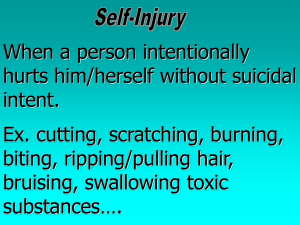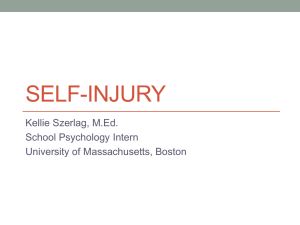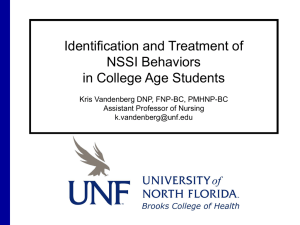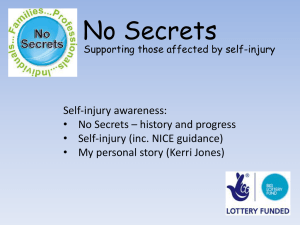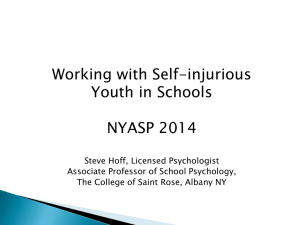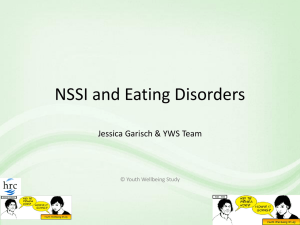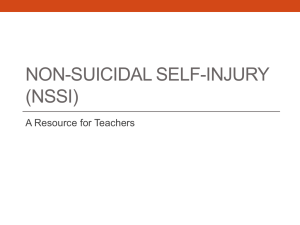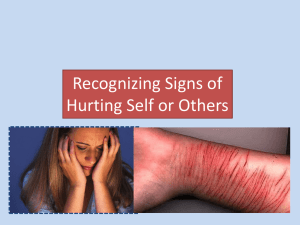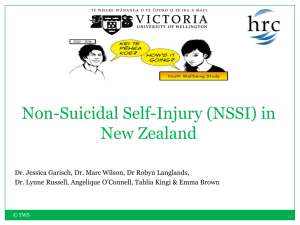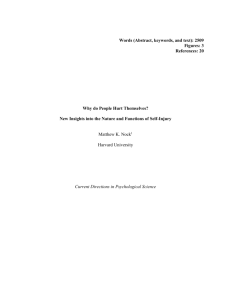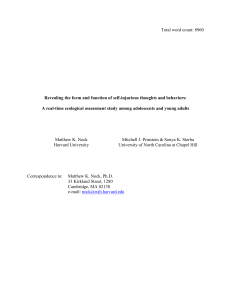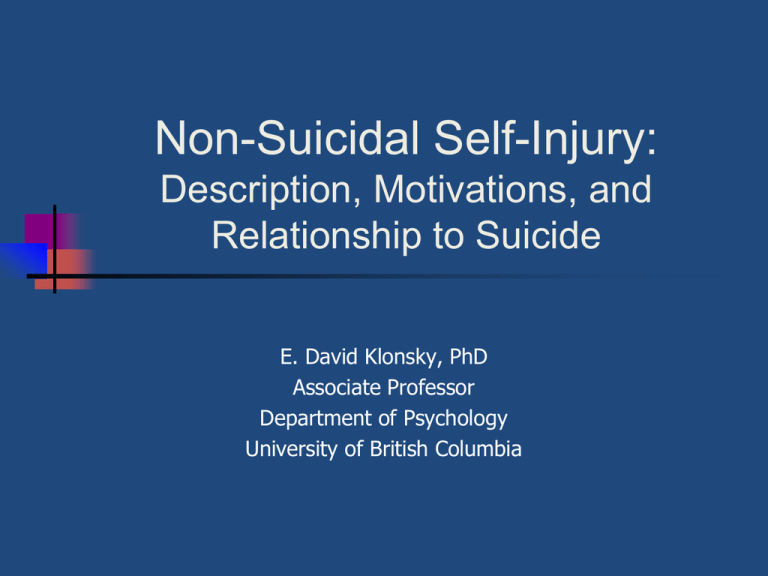
Non-Suicidal Self-Injury:
Description, Motivations, and
Relationship to Suicide
E. David Klonsky, PhD
Associate Professor
Department of Psychology
University of British Columbia
Non-Suicidal Self-Injury
Common in youth and adolescents
Can be confused for attempted suicide
Has an important relationship to suicide risk
Agenda
What is Self-Injury
Who Self-Injures
Why People Self-Injure
Relationship to Suicide
A Preliminary Note
What we know (many many studies)
What we think (one or two studies)
What we don’t know (no research yet)
Agenda
What is Self-Injury
Who Self-Injures
Why People Self-Injure
Relationship to Suicide
What is Self-Injury?
Self-inflicted damage to body tissue
Intentional
No suicidal intent
What is Self-Injury?
Intentional, direct injuring of one’s body
tissue without suicidal intent
Also called: non-suicidal self-injury
(NSSI), self-mutilation, self-injurious
behavior, self-wounding, and deliberate
self-harm.
What is Self-Injury?
Skin-cutting, burning, scratching, rubbing
skin against rough surfaces, interfering
with wound healing
Does not include overdosing, eating
disorder behaviors, alcohol/substance
use, body piercings/tattoos*
Variation in Self-Injury
Frequency
Methods
Medical Severity
Contexts
Motivations
Desire/Efforts to Stop
Agenda
What is Self-Injury
Who Self-Injures
Why People Self-Injure
Relationship to Suicide
Famous Self-Injurers
Princess Diana
Famous Self-Injurers
Angelina Jolie
Famous Self-Injurers
Christina Ricci
Famous Self-Injurers
Drew Barrymore
Famous Self-Injurers
Johnny Depp
Famous Self-Injurers
Eminem
Famous Self-Injurers
Marsha Linehan
Famous Self-Injurers
Harry Potter’s Dobby
Klonsky, E.D. & Laptook, R. (2007). Dobby had to iron his hands, sir! Self-inflicted cuts, burns, and
bruises in Harry Potter. In the Psychology of Harry Potter. BenBella Books.
Who Self-Injures?
Young Adolescents
8%
High-School
14 - 15%
University Students
17%
General Adult Population
4-6%
Adolescent Inpatients
40 - 80%
Klonsky, E.D. & Muehlenkamp, J.J. (2007). Self-injury: A research review for the practitioner.
Journal of Clinical Psychology: In Session.
Psychological Characteristics
Negative Emotions/Emotion Dysregulation
Depression
Anxiety
Anger
Self-Directed Negative Emotion
Suicide Ideation and Attempts
Defining Characteristic
Intense, Self-Directed Negative Emotions?
What About Abuse Histories?
“may be reenacting the abuse perpetrated on
them” (Noll, 2003)
“manifestation of sexual abuse”
(Cavanaugh, 2002)
Abuse “contributes heavily to the initiation of
self-destructive behaviors” (van der Kolk, 1991)
Child Sex Abuse and Self-Injury
Analysis of 44 studies
Median phi = 0.23 (small relationship)
Klonsky, E.D. & Moyer, A. (2008). Childhood sexual abuse and non-suicidal self-injury: Metaanalysis. British Journal of Psychiatry.
Child Sex Abuse and Self-Injury:
Conclusion
Abuse histories can contribute to negative
emotions driving NSSI, but …
… many who self-injure do not have abuse
histories, and many with abuse histories do
not self-injure.
Agenda
What is Self-Injury
Who Self-Injures
Why People Self-Injure
Relationship to Suicide
Why People Self-Injure: Theories
Theory
Description of Theory
Anti-Dissociation
To end the experience of depersonalization or dissociation
Anti-Suicide
To replace or compromise with the impulse to commit suicide
Emotion Regulation
To alleviate intense negative emotions
Interpersonal Boundaries
To assert one’s identity or a distinction between self and other
Interpersonal Influence
To seek help from or manipulate others
Self Punishment
To derogate or express anger towards oneself
Sensation Seeking
To generate excitement or exhilaration
Sexual
To control, distract from, or gratify uncomfortable sexual urges
Why People Self-Injure: Research
Sources of evidence
1) Reasons/motivations for self-injury
2) Experience of self-injury
3) Laboratory studies of proxies for self-injury
Klonsky, E.D. (2007). The functions of deliberate self-injury: A review of the evidence. Clinical Psychology Review.
Why People Self-Injure: Research
Theory
Evidence For Theory
Anti-Dissociation
R, R, R, r, r, r, P, p, -p
Anti-Suicide
R, r, r
Emotion Regulation
R, R, R, R, R, R, R, R, R, R, R, P, P, P, P, P, P, L, L, L
Interpersonal Boundaries
r, r
Interpersonal Influence
R, r, r, r, r, r, r, p, p
Self Punishment
R, R, R, R, R, R, r, r, r, r, r
Sensation Seeking
r, r, r, r, r
Results of 18 studies of reasons [R, r], self-report of phenomenology [P, p], or laboratory data [L, l].
Why People Self-Injure: Research
Primary sources of evidence
1) Reasons/motivations for self-injury
2) Experience of self-injury
Klonsky, E.D. (2007). The functions of deliberate self-injury: A review of the evidence. Clinical Psychology Review.
Why People Self-Injure: Research
Primary sources of evidence
1) Reasons/motivations for self-injury
2) Experience of self-injury
Klonsky, E.D. (2007). The functions of deliberate self-injury: A review of the evidence. Clinical Psychology Review.
Emotion Regulation
50-95% of self-injurers
“To release emotional pressure that builds up inside me”
“To get rid of intolerable emotions”
“To control how I am feeling”
Klonsky, E.D. (2007). The functions of deliberate self-injury: A review of the evidence. Clinical Psychology Review.
Self-Punishment
More than 50% of self-injurers
“To express anger at myself”
“To punish myself”
Klonsky, E.D. (2007). The functions of deliberate self-injury: A review of the evidence. Clinical Psychology Review.
Anti-Suicide
3rd most common reason
“To avoid the impulse to attempt suicide”
“To stop suicidal ideation or attempts”
“To stop me from killing myself”
Klonsky, E.D. (2007). The functions of deliberate self-injury: A review of the evidence. Clinical Psychology Review.
Anti-Dissociation/Depersonalization
4rd most common reason
“To know I am capable of feeling physical pain”
“To feel like myself again”
“To feel real”
Klonsky, E.D. (2007). The functions of deliberate self-injury: A review of the evidence. Clinical Psychology Review.
Interpersonal Influence
5th most common reason
“To let others know what I am going through”
“To get those around me to understand what I’m
going through”
“To get reactions out of people”
Klonsky, E.D. (2007). The functions of deliberate self-injury: A review of the evidence. Clinical Psychology Review.
Sensation/Excitement Seeking
6th most common reason
“To feel exhilarated”
“I thought it would be fun”
Klonsky, E.D. (2007). The functions of deliberate self-injury: A review of the evidence. Clinical Psychology Review.
Why People Self-Injure: Research
Primary sources of evidence
1) Reasons/motivations for self-injury
2) Experience of self-injury
Klonsky, E.D. (2007). The functions of deliberate self-injury: A review of the evidence. Clinical Psychology Review.
Why People Self-Injure: Research
Primary sources of evidence
1) Reasons/motivations for self-injury
2) Experience of self-injury
Klonsky, E.D. (2007). The functions of deliberate self-injury: A review of the evidence. Clinical Psychology Review.
Emotions and Self-Injury
40 Emotions
Before, During, and After Self-Injury
Examples:
Angry, Sad, Lonely, Frustrated, Worthless, Guilty
Happy, Relieved, Hopeful, Satisfied
Bored, Restless, Apathetic
Unreal, Mesmerized, In a Trance
Klonsky, E.D. (2009). The functions of self-injury in young adults who cut themselves:
Clarifying the evidence for affect-regulation. Psychiatry Research.
Emotions and Self-Injury
Before
Overwhelmed
During
Angry at Self
After
Relieved
Sad
Hurt Emotionally
Isolated
Angry at Self
Calm
Hurt Emotionally
Low-Arousal Negative Emotions
"Sad"
5
4
"Lonely"
3.5
2.9
3
3.0
2.9
Before
After
2
1
High-Arousal Negative Emotions
5
"Overwhelmed"
4
3.6
3
"Anxious"
3.6
2.4
2.5
2
1
Before
After
Low-Arousal Positive Emotions
5
Relieved
Calm
4
3.3
2.9
3
2
1
1.5
1.1
Before
After
Big Changes in Negative Arousal
Emotion
Cohen’s d
Relieved
+2.25
Calm
+1.39
Overwhelmed
- 0.89
Anxious
- 0.81
Why People Self-Injure: Theories
Theory
Description of Theory
Anti-Dissociation
To end the experience of depersonalization or dissociation
Anti-Suicide
To replace or compromise with the impulse to commit suicide
Emotion Regulation
To alleviate intense negative emotions
Interpersonal Boundaries
To assert one’s identity or a distinction between self and other
Interpersonal Influence
To seek help from or manipulate others
Self Punishment
To derogate or express anger towards oneself
Sensation Seeking
To generate excitement or exhilaration
Sexual
To control, distract from, or gratify uncomfortable sexual urges
Why People Self-Injure: Theories
Theory
Description of Theory
Anti-Dissociation
To end the experience of depersonalization or dissociation
Anti-Suicide
To replace or compromise with the impulse to commit suicide
Emotion Regulation
To alleviate intense negative emotions
Interpersonal Boundaries
To assert one’s identity or a distinction between self and other
Interpersonal Influence
To seek help from or manipulate others
Self Punishment
To derogate or express anger towards oneself
Sensation Seeking
To generate excitement or exhilaration
Sexual
To control, distract from, or gratify uncomfortable sexual urges
Why People Self-Injure: Theories
Theory
Description of Theory
Anti-Dissociation
To end the experience of depersonalization or dissociation
Anti-Suicide
To replace or compromise with the impulse to commit suicide
Emotion Regulation
To alleviate intense negative arousal
Interpersonal Boundaries
To assert one’s identity or a distinction between self and other
Interpersonal Influence
To seek help from or manipulate others
Self Punishment
To derogate or express anger towards oneself
Sensation Seeking
To generate excitement or exhilaration
Sexual
To control, distract from, or gratify uncomfortable sexual urges
Why People Self-Injure: Theories
Theory
Description of Theory
Anti-Dissociation
To end the experience of depersonalization or dissociation
Anti-Suicide
To replace or compromise with the impulse to commit suicide
Emotion Regulation
To alleviate intense negative arousal
Interpersonal Boundaries
To assert one’s identity or a distinction between self and other
Interpersonal Influence
To seek help from or manipulate others
Self Punishment
To derogate or express anger towards oneself
Sensation Seeking
To generate excitement or exhilaration
Sexual
To control, distract from, or gratify uncomfortable sexual urges
Functions of Self-Injury
1.
Organizing conceptual framework
2.
Valid and comprehensive assessment
Inventory of Statements about Self-injury
(ISAS)
Assesses 13 functions of NSSI
Three items per function
39-item measure
Klonsky, E.D. & Olino. T.O. (2008). Identifying clinically distinct subgroups of self-injurers among
young adults: A latent class analysis. Journal of Consulting and Clinical Psychology.
Klonsky, E.D. & Glenn, C.R. (2009). Assessing the functions of non-suicidal self-injury:
Psychometric properties of the Inventory of Statements About Self-injury (ISAS). Journal of
Psychopathology and Behavioral Assessment.
Sample I-SAS items
“When I harm myself, I am…
Affect Regulation
…calming myself down.
Self-Punishment
…expressing anger towards myself for being worthless or
stupid.
Anti-Suicide
…putting a stop to suicidal thoughts.
Anti-Dissociation
…causing pain so I will stop feeling numb.
Interpersonal Influence
…letting others know the extent of my physical pain.
Sensation Seeking
…doing something to generate excitement or exhilaration.
Peer Bonding
…fitting in with others.
Self-Care
…creating a physical injury that is easier to care for than my
emotional distress
Marking Distress
…creating a physical sign that I feel awful.
Interpersonal
Boundaries
…creating a boundary between myself and others.
Toughness
…seeing if I can stand the pain.
Revenge
…getting back at someone.
Autonomy
…demonstrating I do not need to rely on others for help.
Inventory of Statements about Self-injury
(ISAS)
235 self-injurers from a college sample
18-19 yrs old, 57% female, 42% Caucasian
Hitting self, biting, cutting, pinching,
wound-picking
ISAS Factor loadings
(Exploratory Factor Analysis with Promax Rotation)
Function
Mean (SD)
Social Functions
Intrapersonal Functions
Affect Regulation
3.0 (2.1)
-.14
.69
Anti-Dissociation
1.0 (1.6)
.21
.50
Anti-Suicide
0.8 (1.5)
. 35
.42
Marking Distress
1.5 (1.8)
.04
.82
Self-Punishment
2.0 (2.1)
-.14
.84
Autonomy
0.6 (1.3)
.64
.11
Interpersonal Boundaries
0.8 (1.4)
.52
.26
Interpersonal Influence
0.8 (1.4)
.54
.23
Peer Bonding
0.5 (1.3)
.98
-.26
Revenge
0.6 (1.4)
.53
.16
Self-Care
0.8 (1.4)
.41
.33
Sensation Seeking
0.7 (1.3)
.87
-.18
Toughness
1.0 (1.4)
.65
.02
ISAS Factor loadings
(Exploratory Factor Analysis with Promax Rotation)
Function
Mean (SD)
Social Functions
Intrapersonal Functions
Affect Regulation
3.0 (2.1)
-.14
.69
Anti-Dissociation
1.0 (1.6)
.21
.50
Anti-Suicide
0.8 (1.5)
. 35
.42
Marking Distress
1.5 (1.8)
.04
.82
Self-Punishment
2.0 (2.1)
-.14
.84
Autonomy
0.6 (1.3)
.64
.11
Interpersonal Boundaries
0.8 (1.4)
.52
.26
Interpersonal Influence
0.8 (1.4)
.54
.23
Peer Bonding
0.5 (1.3)
.98
-.26
Revenge
0.6 (1.4)
.53
.16
Self-Care
0.8 (1.4)
.41
.33
Sensation Seeking
0.7 (1.3)
.87
-.18
Toughness
1.0 (1.4)
.65
.02
Relationship of Functions to
NSSI Frequency
Social Functions
NSSI Behavior
Cutting
Needle sticking
Carving
Banging/Hitting self
α = .87
Intrapersonal
Functions
α = .80
.19
Note. All correlations are statistically significant at an alpha of .03.
.30
.19
.18
.13
Relationship of Functions to Cutting
Correlation with Cutting
Affect Regulation
Anti-Dissociation
Anti-Suicide
Marking Distress
Self-Punishment
Autonomy
Interpersonal Boundaries
Interpersonal Influence
Peer Bonding
Revenge
Self-Care
Sensation Seeking
Toughness
.21
.24
.24
.23
.22
.04
.04
.15
-.01
.09
.04
.06
.11
Note. Correlations above .20 are statistically significant at an alpha of .001.
Relationship of Functions to
Clinical Variables
Clinical Variable
Social Functions
α = .87
Intrapersonal
Functions
α = .80
Depression
.24
.42*
Anxiety
.33
.36
Borderline Personality
Disorder
.14
.43*
Note. Correlations above .16 are statistically significant an at alpha level of .01.
* Indicates correlations are significantly different at an alpha of .01.
Relationship of Functions to
Clinical and Contextual Variables
Clinical/Contextual
Variable
Social Functions
α = .87
Intrapersonal
Functions
α = .80
Suicidal Ideation
.10
.32*
Suicide Plans
.14
.33*
Attempted Suicide
.12
.29*
Note. Correlations above .16 are statistically significant an at alpha level of .01.
* Indicates correlations are significantly different at an alpha of .01.
ISAS in Alexian Brothers Hospital
108 psychiatric patients
Ages 11 – 62, mean=19
90% female
72% Caucasian
Function
Social
Intrapersonal
Affect Regulation
.77
Anti-Dissociation
.62
Anti-Suicide
.50
Marking Distress
.75
Self-Punishment
.67
Autonomy
.55
Interpersonal Boundaries
.44
Interpersonal Influence
.51
Peer Bonding
.95
Revenge
.47
Self-Care
.39
Sensation Seeking
.71
Toughness
.37
.41
.43
ISAS in an
Adolescent Psychiatric Sample
80 psychiatric patients with NSSI from South
Oaks Hospital in Long Island, NY
Mean age = 15 (12 - 18)
70% female
61% Caucasian
Function
Social
Intrapersonal
Affect Regulation
.87
Anti-Dissociation
.83
Anti-Suicide
.66
Marking Distress
.63
Self-Punishment
.77
Autonomy
.79
Interpersonal Boundaries
.69
Interpersonal Influence
.54
Peer Bonding
.77
Revenge
.70
Self-Care
.36
Sensation Seeking
.73
Toughness
.72
.37
FASM in Alexian Brothers Sample
Item
Social
Receive more attention (S-P)
.83
Get a reaction (S-P)
.75
Feel more a part of a group (S-P)
.74
Get parents to notice (S-P)
.72
Get attention (S-P)
.64
Avoid something unpleasant (S-N)
.63
Avoid school/work/activities (S-N)
.55
Intrapersonal
Stop bad feelings (I-N)
.68
Feel something (I-P)
.68
Relive feeling numb/empty (I-N)
.64
Punish self (I-P)
.58
Feel relaxed (I-P)
.54
Two Motivational Dimensions
1. Self-Focused
2. Other-Focused
Two Motivational Dimensions
1. Self-Focused
Affect Regulation
Anti-Dissociation
Anti-Suicide
Marking Distress
Self-Punishment
2. Other-Focused
Two Motivational Dimensions
1. Self-Focused
2. Other-Focused
Affect Regulation
Interpersonal Influence
Anti-Dissociation
Peer Bonding
Anti-Suicide
Revenge
Marking Distress
Excitement Seeking
Self-Punishment
Toughness
Two Motivational Dimensions
1. Self-Focused
More Self-Injury
More Psychopathology
More Suicidality
2. Other-Focused
NSSI Motivations: Summary
1.
2.
3.
Most common motivations are emotion regulation
and self-punishment
NSSI motivations fall into two super-ordinate
dimensions: 1) self-focused and 2) other-focused
Self-focused motivations are associated with
greatest clinical severity
Agenda
What is Self-Injury
Who Self-Injures
Why People Self-Injure
Relationship to Suicide
NSSI vs. Attempted Suicide
Differ in terms of intent and medical
severity
Commonly co-occur
Avoid oversimplified conclusions!
Complex relationship needs careful study
NSSI vs. Attempted Suicide
NSSI sometimes mistaken for attempted suicide
Unnecessary hospitalizations
Harms case conceptualization
Misallocates valuable resources
NSSI conveys valuable information regarding
suicide risk
Results from 4 Studies: Does NSSI predict
attempted suicide?
Predictors of Attempted Suicide
139 Adolescent Psychiatric Inpatients
Suicide Ideation
NSSI
.55
.50
Borderline Personality Disorder
Depression
Anxiety
Impulsivity
.37
.20
.16
.11
Predictors of Attempted Suicide
426 High-School Students
Suicide Ideation
NSSI
.51
.38
Borderline Personality Disorder
Depression
Anxiety
Impulsivity
.29
.24
.18
.11
Predictors of Attempted Suicide
1,351 Undergraduates
Suicide Ideation
NSSI
.44
.28
Borderline Personality Disorder
Depression
Anxiety
Impulsivity
.22
.24
.16
.10
Predictors of Attempted Suicide
438 United States Adults
Suicide Ideation
NSSI
.36
.34
Summary of Results From
Four Studies
1.
2.
3.
4.
NSSI relates to attempted suicide
NSSI relates to attempted suicide more
strongly than other risk-factors
NSSI is similar to suicide ideation in conferring
risk for suicide
Yet, like suicide ideation, many/most who
engage in NSSI have not attempted suicide
??
Why does NSSI have such a strong relationship to
attempted suicide?
Thomas Joiner’s Interpersonal-Psychological Theory
Desire + Capability Suicide
??
Most risk factors only confer desire
Depression
Hopelessness
Suicidal ideation
Others only confer capability
Access to lethal means
Combat exposure in military
??
NSSI confers both desire and capability
Desire (intense negative emotions)
Capability (habituation to self-inflicted violence)
(Nock et al., 2006)
NSSI is relatively unique among risk-factors
in that it represents double-trouble!
So what have we learned?
Is NSSI a form of suicidal behavior?
No!
Is NSSI unrelated to attempted suicide?
No!
NSSI is different from attempted suicide, but
confers strong suicide risk because it represents
double-trouble (both desire + capability)
Suicide: Take-Home Message
NSSI is not attempted suicide, but…
… People who self-injure are at greater risk for
suicidal ideation
… People who self-injure are more capable of
acting on suicidal thoughts
For more information…
• Published 2011
• User-friendly information
for health professionals
Thank you
Graduate Students
Catherine Glenn
Alexis May
Sarah Victor
Anita Hibbert
Funding Sources
National Institute of Mental Health
American Foundation for Suicide Prevention
Stony Brook University Center for Survey Research
Thank you!!
Questions, Comments,
Discussion??
Extra Slides
NSSI and BPD
DSM-IV: NSSI is part of a BPD criterion
DSM-5: NSSI proposed as own
diagnostic entity
What exactly is the relationship of NSSI
to BPD?
What BPD and NSSI Share
Frequently co-occur
Both have emotion dysregulation as a
core feature
Both associated with shame
Can NSSI be Distinct from BPD?
198 Adolescent Psychiatric Inpatients
Average of 3.3 Axis-I diagnoses
Two Key Questions:
1.
2.
Does BPD overlap with NSSI more than with
other disorders?
Does NSSI overlap with BPD more than with
other disorders?
Of those with BPD…
… 78% NSSI
… 84% Anxiety Disorder
… 84% Disruptive Behavior Disorder (ODD
or Conduct)
… 78% Mood Disorder
Of those with NSSI…
… 52% BPD
… 74% Anxiety Disorder
… 73% ADHD
… 66% Mood Disorder
NSSI and BPD: Conclusions
NSSI and BPD are correlated, but …
Many who have BPD do not self-injure
Many who self-injure do not have BPD
Clinical Take-Home Message
Diagnosis of BPD is not implied by presence of NSSI, but
made through careful assessment on a case-by-case basis.
Think of BPD and NSSI as you do Depression and Suicidality…
… they often co-occur and even contribute to one another,
yet are best view as distinct phenomena
Agenda
What is Self-Injury
Who Self-Injures
Why People Self-Injure
Key Clinical Issues:
Borderline Personality Disorder
DSM-5
Suicide
A Distinct NSSI Diagnosis?
A symptom of a personality disorder in DSM-IV
Proposed as a Behavioral Disorder for DSM-V
94
The Process
Group of Experts
Members from Mood Disorders and Child/Adolescent Disorders
Workgroups
Advisors with particular expertise in NSSI
Lots of phone and email discussions
Separateness
Independent Clinical Significance
Threshold
Defining Characteristics
Differentiation from other Behaviors/Disorders
95
And the proposed NSSI
diagnosis is ………..
…not going to take effect in DSM-5
… but will appear in DSM-5 appendix as a
research diagnosis
A. In the last year, the individual has, on 5 or more days, engaged in
intentional self-inflicted damage to the surface of his or her body, of a sort
likely to induce bleeding or bruising or pain (e.g., cutting, burning, stabbing,
hitting, excessive rubbing), for purposes not socially sanctioned (e.g., body
piercing, tattooing, etc.), but performed with the expectation that the injury
will lead to only minor or moderate physical harm. The absence of suicidal
intent is either reported by the patient or can be inferred by frequent use of
methods that the patient knows, by experience, not to have lethal potential.
(When uncertain, code with NOS 2.) The behavior is not of a common and
trivial nature, such as picking at a wound or nail biting.
B. The intentional injury is associated with at least 2 of the following:
1. Negative feelings or thoughts, such as depression, anxiety, tension,
anger, generalized distress, or self-criticism, occurring in the period
immediately prior to the self-injurious act.
2. Prior to engaging in the act, a period of preoccupation with the intended
behavior that is difficult to resist.
3. The urge to engage in self-injury occurs frequently, although it might not
be acted upon.
4. The activity is engaged in with a purpose; this might be relief from a
negative feeling/cognitive state or interpersonal difficulty or induction of a
positive feeling state. The patient anticipates these will occur either during
or immediately following the self-injury.
97
Agenda
What is Self-Injury
Who Self-Injures
Why People Self-Injure
Key Clinical Issues:
Borderline Personality Disorder
DSM-5
Suicide
Some Overall Clinical Conclusions
Treatment should emphasize
Functions (functional assessment)
Negative Emotions (emotion regulation skills)
Self-criticism (cognitive techniques)
Arousal regulation (exercise?)
Careful Diagnosis
Suicidality should be carefully monitored
Choose your own adventure
1.
Why do people choose NSSI and not something
else? (role of self-derogation/criticism)
2.
Physiologically speaking, how does NSSI work?
3.
Is NSSI an ‘addictive’ behavior?
4.
Why is physical pain reduced in NSSI?
Many ways to cope with negative
emotions …
why self-injury?
Self-Derogation
Self-injurers consistently score high on measures of selfderogation, self-criticism, and low self-esteem
Klonsky, Oltmanns, & Turkheimer, 2003, American Journal of Psychiatry; Klonsky & Muehlenkamp, 2007,
Journal of Clinical Psychology/In Session; Glassman et al., 2007, Behaviour Research and Therapy)
Self-punishment/self-directed anger is the second most
common motivation for self-injury (Klonsky, 2007, Clinical Psychology Review)
“To express anger at myself”
(Klonsky, 2009, Psychiatry Research)
NESD Theory
For those high in negative emotionality (NE) and
self-derogation (SD) …
… Self-injury is an ego-syntonic regulation method
… Self-injury uniquely fulfills a self punishment function
NESD Model
Temperament
Intense self-derogation
Self-injury
Intense, negative
emotions
Environment
Normative/Low
self-derogation
Other
healthy &
unhealthy
coping
NESD Theory
Hypothesis: Those high in both negative
emotionality (NE) and self-derogation (SD) are
most likely to self-injure
Predicts a statistical interaction between NE and
SD in identifying self-injurers
Sample 1: Young Adults
2,011 Air Force recruits in basic training
Thomas, Turkheimer, & Oltmanns. (2003). Factorial structure of pathological personality traits as evaluated by
peers. Journal of Abnormal Psychology.
Mean age 20 (SD=5), 62% Male, 65% Caucasian,
17% African American
Administered the Schedule for Nonadaptive and Adaptive
Personality (SNAP; Clark, 1996)
Self-Injury
“When I get very tense, hurting myself physically
somehow calms me down”
“I have hurt myself on purpose several times”
1% endorsed both of these items
Negative Emotionality
SNAP Negative Temperament Scale
28 items: “I often have strong feelings such as anxiety
or anger..”
True-False format
Self-Derogation
SNAP Self-Derogation/Low Self-Esteem scale
7 items: “I’ve really made a mess of my life”
True-False format
Results
Frequent Injurers
Negative Emotionality (NE)
1.29
Self-Derogation (SD)
1.49
Control
-.01
-.01
NE and SD interact to distinguish frequent cutters from
controls (Binary Logistic Regression: Wald’s X2(1)=3.24, p=.07)
Percentage of Frequent Self-Injurers
in NESD Categories
100%
90%
80%
70%
60%
50%
40%
30%
20%
10%
0%
Low Both
Low NE,
High SD
High NE,
Low SD
High Both
Sample 2: Adolescents
432 high-school students
Ages 13-17, 61% Female
53% Caucasian, 19% Hispanic, 15% Asian,
11% African American
Self-Injury
Section I of the Inventory of Statements About Self-injury
(ISAS; Klonsky & Olino, 2008; Klonsky & Glenn, in press)
Self-injurious behaviors done “intentionally” and “without
suicidal intent”
12 different behaviors: “cutting,” “scratching,” “needlesticking”
6.5% Cut 3 or more times
Negative Emotionality
Composite of two measures
1.
2.
Positive and Negative Affect Scale (PANAS; Watson & Clark, 1994)
10-items: “Upset,” “Ashamed,” “Irritable” [just NA scale]
Difficulties in Emotion Regulation Scale (DERS; Gratz, 2004)
36-items: “When I’m upset, my emotions feel overwhelming”
PANAS NA scale and DERS correlated r=.68
Self-Derogation
Composite of three measures
1.
2.
Self-Derogation scale from the Schedule for Nonadaptive and
Adaptive Personality (SNAP; Clark, 1996)
7-items: “I’ve really made a mess of my life”
Self-Perception Profile for Adolescents-Revised (SPPA; Harter, 1988;
Wichstrom, 1995)
Global Self-Worth 5-items: “often disappointed with [yourself]”
Physical Appearance 5-items: “not happy with the way [you] look”
Results
Frequent Cutters
Control
Negative Emotionality (NE)
1.01
-.07
Self-Derogation (SD)
1.16
-.07
NE and SD interact to distinguish frequent cutters from
controls (Binary Logistic Regression: Wald’s X2(1)=3.86, p<.05)
Percentage of Frequent Skin-Cutters
in NESD Categories
100%
90%
80%
70%
60%
50%
40%
30%
20%
10%
0%
Low Both
Low NE,
High SD
High NE,
Low SD
High Both
NESD Theory: Next Steps
Preliminary evidence supports NESD theory
Examine large group of severe self-injurers
Consider functions of self-injury
(e.g., Klonsky & Olino, 2008)
How Does NSSI Work?
Parasympathetic Rebound Theory
Parasympathetic Rebound Theory
Sympathetic nervous system – “fight or flight”
Intense emotion: Fear, rage, panic
Increases heart rate
Increases blood flow to major muscle gruops
Parasympathetic nervous system – “rest and digest”
Limits effects of sympathetic system
Slows heart rate
Facilitates sustained engagement and attention
Parasympathetic Impairment
Inability to restrain sympathetic responses and emotions
(panic, anger)
Impaired parasympathetic activity observed in self-injury and
Borderline Personality Disorder (Austin et al, 2007; Crowell et al., 2005;
Weinberg, Hajcak, Klonsky, 2009)
Parasympathetic Rebound
Surges in sympathetic activity are followed by increases in
parasympathetic activity
What if surges are too strong or too weak?
Too strong: fainting
Too weak: emotional dysregulation observed in BPD and self-injurers
Perhaps self-injury causes a surge in sympathetic activity
which in turn triggers a strong parasympathetic rebound?
Parasympathetic Rebound
Some self-injurers report that seeing the blood is
important for achieving calming influence of selfinjury (Glenn & Klonsky, 2010)
Interestingly, the fainting response observed in
blood phobics is often attributed to parasympathetic
rebound
The pain and blood caused by self-injury may both
trigger a parasympathetic rebound
Parasympathetic Activity
Pre- and Post- Self-Injury
90
80
70
Mean
RSA
60
50
40
30
20
10
0
1
2
3
4
5
6
7
8
9
10 11 12 13 14 15 16 17 18 19 20 21
Minutes
NSSI
Data from Matthew Nock, shown with permission (Nock & Mendes, in preparation)

